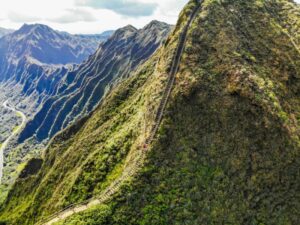Unless you’re a bleeding-edge alpinist, there’s not a whole lot left to say about the Eiger North Face. It’s historical; it’s massive; it’s dangerous and scary. It’s also a stage where climbers have executed acts of heroism and tragedy for nearly a century. Generations of tourists at Kleine Scheidegg have watched it all play out from the base of the wall.
The BBC tries to condense the epic into an hour in its 2010 documentary Eiger: Wall of Death. Diligent primary sourcing and a historical approach help it stand out from its sometimes-melodramatic cinematography and script.
Still, it does portray the Nordwand for what it’s always been: climbing’s most visible high-stakes proving ground.
Back in the day on the Eiger North Face
In 1936, tourists at Kleine Scheidegg watched through observation glasses as guides tried to rescue German climber Tony Kurz. Ice- and rockfall had ripped his entire team off the wall, and now he dangled in space at the end of a rope. He hung there for three days until he died, beyond the reach of rescuers and unable to cut the rope with his deeply frostbitten hands.
Two years later, eyes were glued to Anderl Heckmair and Heinrich Harrer’s team as they made the harrowing first ascent with the help of an amphetamine elixir. The team climbed fast during breaks between avalanches over the course of three days. Their route was an instant classic, but the drug regimen and Harrer’s strong Nazi affiliation gave the story a lasting and bizarre legacy.

Andreas “Anderl” Heckmair, late 1930s.
Current action on the Nordwand
Fast forward a few generations to 2015, when Ueli Steck charged up the 1,800m wall alone in a mind-bending 2 hours, 22 minutes and 50 seconds. You might have been in Kleine Scheidegg to witness the ascent, but you could have missed every inch of it if your imagination got too carried away in the contents of a single frosty mug. Steck’s speed record still stands.

Steck climbing in Chamonix. Photo courtesy of Jonathan Griffith
Why watch Eiger: Wall of Death? (And by extension, why climb?)
Eiger: Wall of Death is far from an intimate portrait of climbing on the Eiger. However, it does manage to strike a nerve near the grim heart of alpinism. It’s unsettling to watch Steck call his Eiger tactics “futuristic” with the knowledge that they’d kill him in the Himalaya less than a decade later. And hard-luck, would-be rescuer Brian Nally cuts a haunting figure as he somberly tells the story of his partner, Barry Brewster, dying in his arms after a bad fall.
Compare that to British climber Chris Bonington’s borderline cavalier attitude toward death, which crops up frequently throughout the film. Bonington would make the first British ascent of the Eiger and build an energetic, celebrated career that continues today. Nally faded into near-total obscurity.
So what’s the point? Why struggle up this brutal curtain of ice and rock at all? You can literally walk up the other side of the Eiger to get to the top. But at one point, the North Face had seen 12 successful ascents and killed 14 people.

The Eiger North Face from Kleine Scheidegg. Photo: Eric Middelkoop.
We don’t have the answers, and the BBC certainly didn’t. But if you watch carefully, Eiger: Wall of Death can at least lead you to climbing’s pivotal question:
“Why?”






